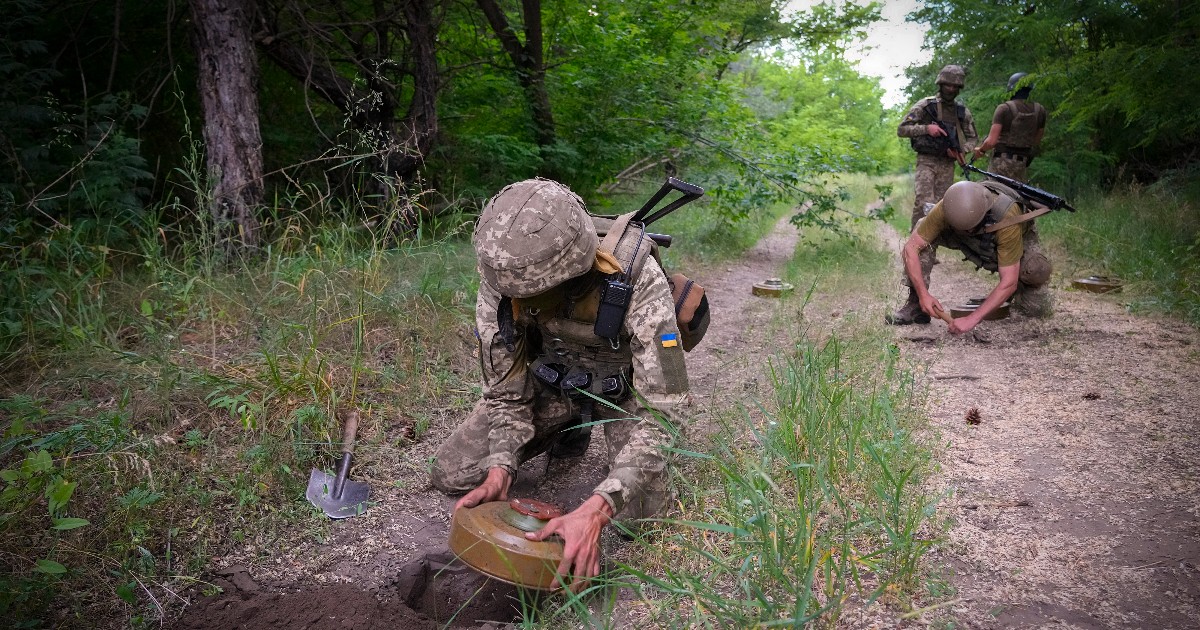
To the east the steppe is still largely barren, but there are a few pine forests with very tall trunks planted in the ground in the last thirty years which cover patchy parts of the non-urban territory. It is in these areas, a continuous alternation of barren hillocks, dense forests and small river valleys, at the junction of the Kharkiv, Luhansk and Donetsk oblasts, that Russia launches mostly untrained conscripts against Ukrainian defensive positions
Independence has been good for the Ukrainian woods: Since 1988, the area covered by trees has grown by almost a million hectares, mostly tall trees planted by the government. This is especially true in the western part: in the east the steppe it is still largely barren, but there are few forests of beans with a very high trunk placed in the ground in the last thirty years covering parts of the non-urban territory in a patchy pattern. It is in these areas, a continuous alternation of barren hills, dense forests and valleys crossed by rivers that are frozen for the moment, at the crossroads between the oblasts of Kharkiv, Luhansk e Donetskthat the Russia throws mostly untrained conscripts against Ukrainian defensive positions, mostly trenches, rural buildings, railway infrastructure and often too makeshift locations defensible by the conformation of the territory.
These are above all platoons of 10-20 young people at a time, fresh from mobilisation, who, once “mowed down” by machine guns, are tucked in by troupe Wagnermore professional and trained. Forests make up the natural defence more unexpected but no less effective: they make i invisible snipers looking for officers to kill, they provide coverage and the possibility of moving around in safety mortars Ukrainians, allow the less disciplined Russian soldiers to slip en masse around sensitive targets and then pop up from multiple sides. Above all, in one war of attrition where the surface of the territory counts for a lot, the wooded areas have become the protagonists of epic clashes reminiscent of those of the WWIlike the infamous Meuse-Argonne Offensive in which, during the first hours of the clash, the Americans alone fired more ammunition than in four years of the Civil War, equal to about 3.5 billion current dollars. The Forest of Argonne became a “green hell” for soldiers: small German patrols, mined traps and barbed wire pinned down and destroyed much of the US 77th Infantry Division which also came under friendly fire at one point. Famous is the message sent with a carrier pigeon with which they asked “for heaven’s sake” to stop shooting at them. The story in the forests between Kreminna e Bakhmut it is similar: the sudden shortage of mortars forced the Ukrainians to make extensive use of machine guns, but these are only effective when the enemy is far enough away. If he lunges forward, a Russian soldier too close, as they well know in those parts, can only be knocked down by hitting him on the head with the weapon. Fighting between endless rows of pine trees and small bushes, it is easy to suddenly find the enemy close enough to recognize the color of the eyes or not too far away to be able to shoot with the certainty of hitting the target without being seen.
Just the mineas in the Argonne Forest, have returned to being the great protagonists: the Ukrainians have learned to place them quickly and effectively to prevent the Russians from following them during tactical retreats, in order to avoid sudden accelerations by the Russians from throwing chaos on the move. In short, if your enemy has to waste precious time (as well as men) clearing the ground during an advance, you have plenty of time to reposition yourself in fortified places and in turn open fire, while the attacker is uncovered. You can do this, however, only around and in wooded areas: too large, dense and humid to be “flattened” like inhabited centres. So under the pine trees you can find shelter from the omnipresent droneswhich with difficulty cross the crowns of evergreen trees in the thickest points.
It is not the first time that the troops of the Kremlin suffer the consequences of the presence of wooded areas in the land they cross: it also happened in March, during the fall of the Belarus verso Kievthen interrupted between Hostomel e loofahwhen Ukrainian soldiers and volunteers, armed with Javelin e you suicide drones, they came out of the forests for deadly attacks and then found refuge there. But also in the advance from Amounts towards the Ukrainian capital, a year ago, the forests around Brovary they forced the Russians to carry out slow and predictable maneuvers, with logistics always in crisis. In short, the Russians found themselves in the same dangerous situations, surrounded by woods full of fierce defenders, as happened to their ancestors in the wars of the Caucasus of the 19th century: not surprisingly, once they prevailed over the Chechens and other Islamic populations, a decision was deforestation Of the territory.
The Australian Armyone of the few to prepare the jungle warfare, argues that forest warfare is always conducted as close combat: the winner is the one who has the ability to quickly seize the initiative and inflict both controlled and overwhelming blows. Therefore, the time spent preparing soldiers before immersion in the forest is essential, even if this genre of combat demands complex exercises designed to maximize an organization’s lethality while improving survivability. Needless to say: in this war no one had prepared for battles fought among thousands of pine trees.
